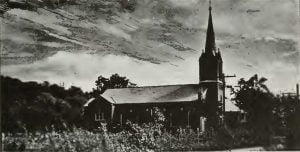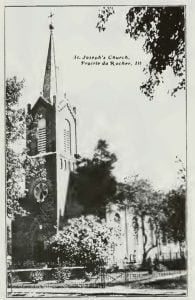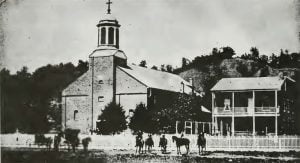St. Joseph Church Prairie du Rocher, Illinois, was established in 1722 as a chapel dependent upon the royally endowed church of Ste. Anne at Fort Chartres. King Louis XIV of France had dreamed of a great French empire in Mid America, but died before he could bring his dream to reality. Following his death in 1715, the regent, Philip of Orleans, ruling for the boy King Louis XV, commissioned Pierre Duque Boisbriant to found Fort Chartres in 1718 on the mighty Mississippi, midway between Quebec and New Orleans, to be the capital of the new French empire in Mid America. The fort was named after the Due de Chartres, son of the regent, and was the functioning capital of the Illinois country, then a French possession.
From the beginning of the fort a church was established in the village of Nouvelle Chartres outside the walls. It was staffed by two Jesuit priests, Father Le Boullenger and Father De Beaubois, who cared for the spiritual needs of the soldiers garrisoned at the fort, and the French families of the area surrounding the fort.
Soon the swampy condition of the soil near the fort prompted some of the French settlers to move to higher ground at the foot of the picturesque rock bluffs. Jean St. Therese Langlois, the nephew of Pierre Duque Boisbriant, commandant of the king, received from his uncle the commandant, a grant of land for a village beneath the bluffs. They called it “La Belle Prairie du Rocher,” namely, “The Beautiful Meadow Beneath the Rock.”

A chapel of logs in what is the present and original cemetery was erected for the convenience of the people, so that they would not have to travel the muddy three miles to Ste. Anne at the fort. In 1734 this small chapel was replaced by a larger log church. A similar chapel was established at St. Philipe near what is now Renault and Harrisonville, and was called Our Lady of the Visitation. The river washed away completely the settlement and chapel at St. Philipe. In 1765, two years after all the rest of the Mississippi valley had been surrendered to the British, Fort Chartres likewise surrendered.
It was a sad day for the French in Mid America. Fort Chartres was the last place in America to fly the Bourbon flag of France, the three golden fleur-de lis on a background of blue. When the Bourbon flag was hauled down and the British flag hoisted in its place, an era had ended. Great changes were in the making.
The royal church of Ste. Anne was abandoned and soon fell into disrepair. St. Joseph chapel alone survived, and became the parish church for the area, supplanting, or rather, continuing the mother church of Ste. Anne.

In 1767 the records and sacred vessels of Ste. Anne were transferred to St. Joseph at Prairie du Rocher. The few remaining French at Nouvelle Chartres demanded them back, and a civil suit was entered in the British court. The court awarded them back to Ste. Anne. But by that time the church was without roof, and no priest was stationed there, and for safekeeping these priceless treasures were returned to St. Joseph at Prairie du Rocher, where they remain to this day and are the marvel and admiration of historians.
St. Joseph Church, the village of Prairie du Rocher, and Fort Chartres are the only living remnants of the attempt at a French empire in Mid America. Founded under the royal patronage of the Bourbon Kings of France both parish and town have survived the Bourbon kings themselves, the British rule, and finally the founding and development of the United States of America.
St. Joseph Church venerable in its antiquity and the village of Prairie du Rocher are the only living monument of the French power in Mid America. The sacred vessels inherited from the mother church of Ste. Anne are the only usable relics of a colorful epoch that ended on a note of tragedy.

The present church building dates from 1850, and was inspired by the churches of Rome. Two residents of Prairie du Rocher, returning from the Holy Year of 1850, agitated for a new church. The foundations were laid to the right of the old log church, but in 1851 came the great flood. It seemed imprudent to continue to build the new church there, for the floods had surrounded the site, cutting off access from the rest of the village. So the foundations were abandoned, and the church built at this present site. The Romanesque style, especially the flat ceiling, were copied after the famous basilicas and. churches of Rome. The corner stone was laid July 19, 1858. St. Joseph was never an Indian Mission but was for the French from the Start. It is thus the only truly French parish in the diocese.
A careful examination of the parish registers reveals various important data besides the simple narrative of baptisms, marriages and deaths. The entries are all made in French. It is regretted that only three badly tattered leaflets remain of the first parish register extending to October, 1743. These pages record merely baptisms, which are signed by the Jesuit Fathers, Ignatius Le Boullenger and Nicolas Ignatius de Beaubois. Le Boullenger appears to have been the founder of the parish, and Charlecois states that in 1721, when he visited the Illinois County, Father Joseph Francis de Kercben, S. J., assisted him. Beaubois was stationed at Kaskaskia. The Jesuits probably remained in charge of the parish until Father J. Gagnon assumed the postulate in 1743.
Priests Who Served St. Joseph Church, Prairie du Rocher
- Ignatius Le Boullenger, S. J. 1721-1726
- Nicholas Ignatius de Beaubois, S. J. 1726
- J. Gagnon. Pretre Miss. Apost. 1743-1755
- Nicolas Laurenz, Pretre Miss. Apost. 1747; Pierre Mercier, V. G.
- Philibert Watrin, S. J. 1744 and 1760 (of Quebec, 1749)
- Forget Duverger, Fr. Miss. Apost. 1757-1759
- Francis John Baptiste Aubert, S. J. 1758-1759
- Hypolyte Collet, Recollect Miss. 1757-1764
- Luc Collet, Recollect Miss. 1762-1765
- Sebastian Louis Meurin, S. J. 1765-1777, V.G.
- Pierre Gibault 1770-1791, V.G. of Quebec
- De St. Pierre 1785-1792, Cure de Ste. Genevieve
- De Valinierre 1786-1788, V.G.
- Le Dru 1789-1792, Cure des Kaskaskias
- Levadoux, V.G. 1792
- Gabriel, Richard 1793-1798
- C. Lusson 1798
- H. F. Didier 1798
- J. Fr. Rivet, V.G. of Baltimore 1798-1799
- Donation Oliver 1798-1827
- John Timon. CM. 1826-1827, later Bishop of Buffalo
- Pierre Vergani, CM. 1827-1828
- Francis Cellini, 1827, 1830
- P.J. Doutrelluingue, CM. 1829-1830
- Vital Van Cloosterell, 1832-1854
- A. Mascaroni 1830-1831
- John Francis Regis Loisel 1830
- Fr. Borgna 1830
- Victor Paillaison 1830, 1831
- J. N. Odin, CM. 1832
- E. Dupuy 1832
- P. Lefevre 1833
- N. J. Perrin 1855-1859
- Francis Recouvreur 1860, 1862
- J. A. Jacque 1861, 1862
- Henry Fredrick Frohboese 1864—1876
- Anthony Vogt 1876
- Charles Krewet 1876-1902
- James Gillen 1899-1902
- Charles Eschmann 1902-1911
- William Van Delft 1911-1940
- Stephen Freund 1940
- Raymond L. Harbaugh 1940-1948
- Elmer J. Holtgrave 1948-1956
- Theodore Siekmann 1956-1968
- Walter MacPherson & Ralph Haas
- Jerome B. Ratermann 1968-1971
- Eugene Bungay 1971 –
